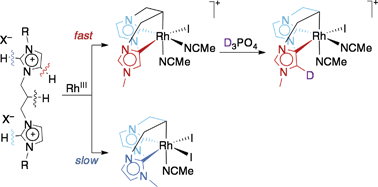Smooth C(alkyl)–H bond activation in rhodium complexes comprising abnormal carbene ligands†
Abstract
Rhodation of trimethylene-bridged diimidazolium salts induces the intramolecular activation of an

* Corresponding authors
a
School of Chemistry and Chemical Biology, University College Dublin, Belfield, Dublin 4, Ireland
E-mail:
martin.albrecht@ucd.ie
Fax: +353-17162501
Tel: +353-17162504
b
School of Engineering and Physical Sciences, William Perkin Building, Heriot-Watt University, Edinburgh, U.K.
E-mail:
s.a.macgregor@hw.ac.uk
c XRD Application Lab, CSEM, Rue Jaquet-Droz 1, CH-2002 Neuchâtel, Switzerland
Rhodation of trimethylene-bridged diimidazolium salts induces the intramolecular activation of an

 Please wait while we load your content...
Something went wrong. Try again?
Please wait while we load your content...
Something went wrong. Try again?
A. Krüger, L. J. L. Häller, H. Müller-Bunz, O. Serada, A. Neels, S. A. Macgregor and M. Albrecht, Dalton Trans., 2011, 40, 9911 DOI: 10.1039/C1DT11116G
To request permission to reproduce material from this article, please go to the Copyright Clearance Center request page.
If you are an author contributing to an RSC publication, you do not need to request permission provided correct acknowledgement is given.
If you are the author of this article, you do not need to request permission to reproduce figures and diagrams provided correct acknowledgement is given. If you want to reproduce the whole article in a third-party publication (excluding your thesis/dissertation for which permission is not required) please go to the Copyright Clearance Center request page.
Read more about how to correctly acknowledge RSC content.
 Fetching data from CrossRef.
Fetching data from CrossRef.
This may take some time to load.
Loading related content
